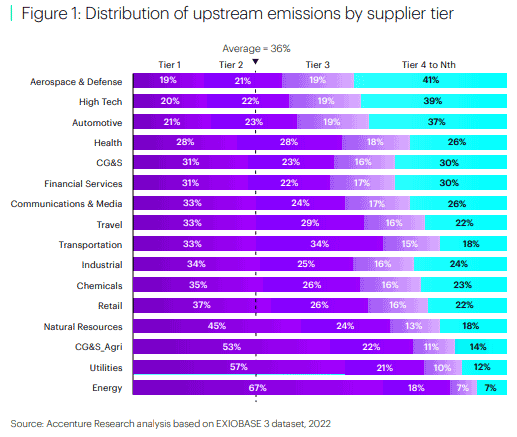A new report from consulting firm Accenture finds many if not most manufacturers and brand companies will not reach so-called zero emissions goals for carbon if they don’t get improved visibility to emissions from tier 2 and tier 3 suppliers.
Supply Chain Digest Says...
|
 |
| "With these insights, companies can identify where and how they should allocate their time and resources to reduce emissions,” Accenture notes. |
 |
What do you say? |
| Click here to send us your comments |
|
 |
| Click here to see reader feedback |
|
“Scope 3 emissions are elusive and difficult to track in today’s complex supply chains. Many large companies don’t even know the suppliers beyond Tier 1, let alone have any sort of influence or control over them or their sustainability practices, which is why we have seen little progress in reductions to date,” said Kris Timmermans, Accenture’s supply chain practice lead. “Armed with the knowledge of where their emissions sit, companies can do the really important thing – commit to taking action and collaboration with the entire supplier base and all stakeholders, toward a more sustainable future.”
This lack of visibility deeper in the supply chain prevents companies from taking the actions necessary to accelerate their progress in reducing these emissions, increasing supply chain sustainability and lowering their overall carbon footprint, Accenture adds.
Looking at this complex scenarios, Accenture offers three key takeaways from their research:
Network complexity strongly influences emissions strategies: Some sectors tend to have emission sources close to home, while other, such as Aerospace and defense, high tech, and automotive, have heavy emission much further back in their supply chains, where it’s hard to see and track.
For example, on average, 80% of high tech company's upstream emissions come from Tier 2+ suppliers. (See graphic below.)
Sources of emissions vary significantly by industry sector: along the same lines, just where in a given supply chain emission “hot spots” are located varies by sector and individual company.

Without having emissions visibility across all tiers of the supply chain, “companies may end up focusing and spending resources on actions for different sources that ultimately may not have much of an impact on reducing overall Scope 3 emissions,” Accenture notes.
(See More Below)
|
CATEGORY SPONSOR: SOFTEON |
|
|
| |
|
|
Within an industry, a supplier’s location has a big impact on its emissions: Suppliers of the same types of products can have big differences in CO2 emissions. The report cites, for example, that when it comes to metal production, US companies tend to have much lower emissions per unit than those in India. Why? In India, the energy raw material (mainly coal) supplying industry comprises 77% of all upstream emissions. In the United States, it’s only 10%.
"With these insights, companies can identify where and how they should allocate their time and resources to reduce emissions,” Accenture notes.
These insights can also help companies more effectively integrate sustainability into their supply chain sourcing activities, including category planning and supplier selection, Accenture concludes.
Any reaction to this Accenture analysis? Let us know your thoughts at the Feedback section below.
|